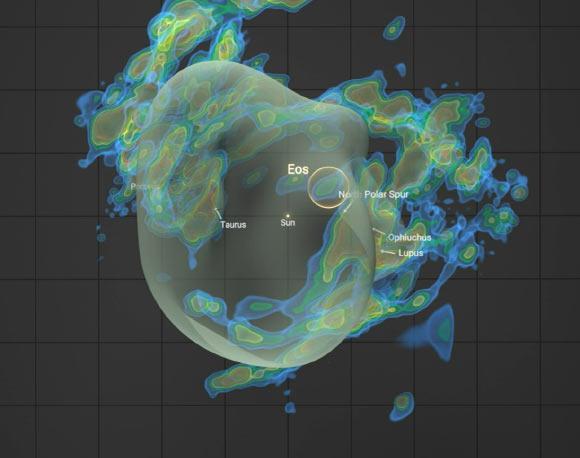
Mysterious Structure, 40 Times the Size of the Moon, Found Near Earth
In a groundbreaking discovery, scientists have stumbled upon a massive molecular cloud, measuring approximately 40 times the size of the Moon, near our planet. Dubbed “Eos” after the Greek goddess of dawn, this enigmatic structure has been hiding in plain sight, waiting to be uncovered. According to researchers, this is the first-ever molecular cloud to be discovered through the detection of far ultraviolet emission of molecular hydrogen directly.
The findings were made possible by a team of scientists from Rutgers University, who used advanced telescopes to scan the sky for signs of molecular hydrogen. The researchers were able to pinpoint the location of Eos by focusing on the far ultraviolet emission of molecular hydrogen, a phenomenon that had previously gone undetected.
Molecular clouds are vast, interstellar regions filled with gas and dust. They play a crucial role in the formation of stars and planets, as they provide the raw materials for these celestial bodies to take shape. However, Eos is unlike any other molecular cloud discovered to date. Its sheer size and proximity to Earth make it a fascinating and mysterious find.
“We’ve been looking for this kind of emission for a long time, and we finally found it,” said Dr. Michael Kaufman, a researcher involved in the study. “It’s like a big, invisible cloud that’s been hiding in plain sight. We’re excited to learn more about it.”
Eos is estimated to be around 40 times larger than the Moon, measuring approximately 100 light-years in diameter. To put that in perspective, the Moon is about 2,159 miles (3,475 kilometers) in diameter, so Eos would be roughly 8,636,000 miles (13,882,000 kilometers) across.
The researchers believe that Eos is likely to be a relatively young molecular cloud, with an age of around 100,000 to 500,000 years. This is significant, as it suggests that the cloud may still be in the process of collapsing and forming stars.
“This is a really exciting discovery,” said Dr. Jim Stone, another researcher involved in the study. “We’ve never seen a molecular cloud this big and close to the solar system before. It’s a game-changer for our understanding of star formation and the evolution of the universe.”
The discovery of Eos has significant implications for our understanding of the universe. It suggests that there may be many more massive molecular clouds hidden in the depths of space, waiting to be discovered. This, in turn, could lead to a greater understanding of the formation of stars and planets, as well as the evolution of the universe as a whole.
The researchers plan to continue studying Eos, using advanced telescopes and instruments to gather more data about this mysterious structure. They hope to learn more about its composition, age, and potential for forming stars.
As we continue to explore the mysteries of the universe, discoveries like Eos remind us of the awe-inspiring scale and complexity of the cosmos. Despite being a relatively young field of study, astrobiology and astrophysics have already revealed so much about the universe and its many wonders.
As we look to the future, it is likely that we will continue to make groundbreaking discoveries, shedding light on the mysteries of the universe and expanding our understanding of the cosmos. The discovery of Eos is a testament to the power of human curiosity and the importance of continued exploration and research.
Source: https://www.rutgers.edu/news/vast-molecular-cloud-long-invisible-discovered-near-solar-system






